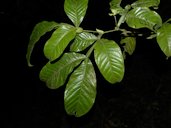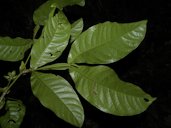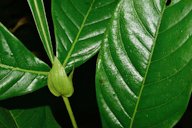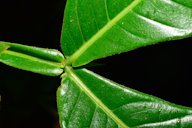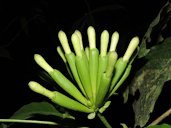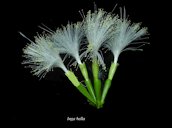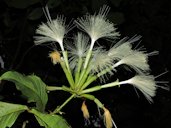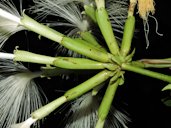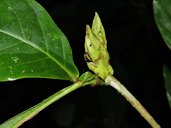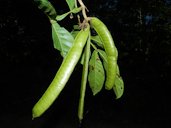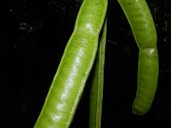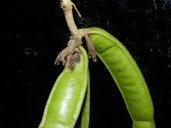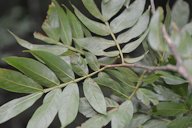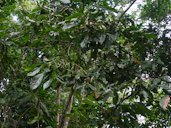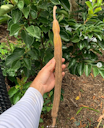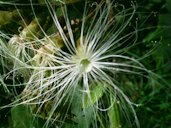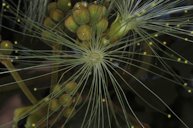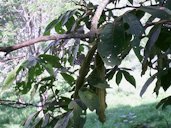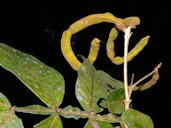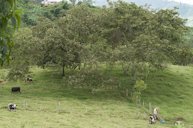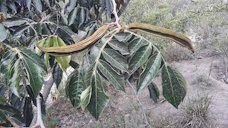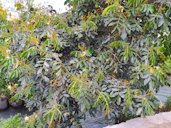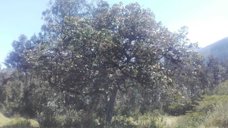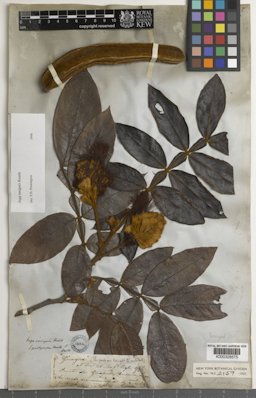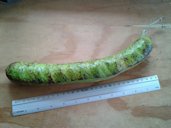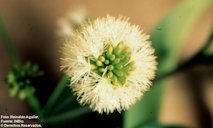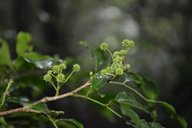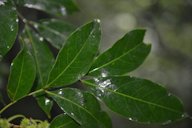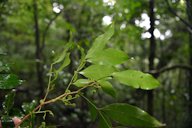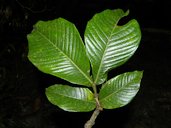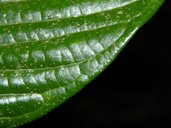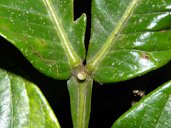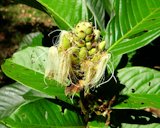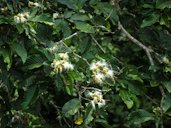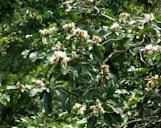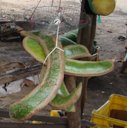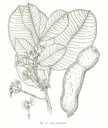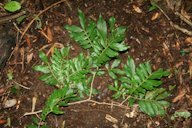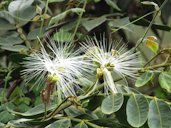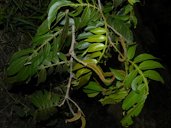| Inga Species with Edible Fruit | |||||||||||||||||||||||||
|---|---|---|---|---|---|---|---|---|---|---|---|---|---|---|---|---|---|---|---|---|---|---|---|---|---|
| Back
to Ice Cream Bean Page  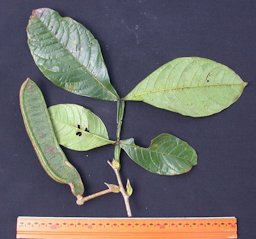 Fig. 1  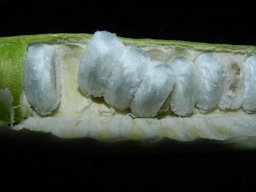 Fig. 2  |
Inga
bella M. Sousa Range: Costa Rica, Panama
|
||||||||||||||||||||||||
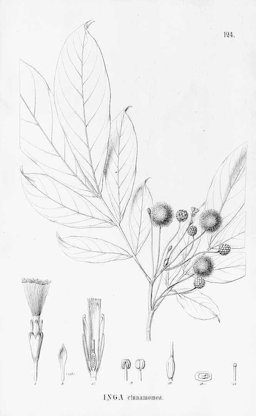 Fig. 15  |
Inga cinnamomea Spruce
ex Benth. Common names: Peru: shimbillo, pacae, vaca shimbillo, shimbillo vaca paleta; Bolivia: pacay blanco; Brazil: ingá-chinelo, ingá-guaçu, ingá bau, ingá açu, ingá bãtelao, ingá grande, iingá grosse 2,5 Synonym: Feuilleea cinnamomea (Spruce ex Benth.) Kuntze, Inga tessmannii Harms var. Harmsii J. F. Macbr. 3,5 Range: Amazonian South America, in floodplain forests 4,5 In Brazil, the common names include suffixes that are unique and aptly describe the fruit. Ingá açu and ingá grande mean large inga, in reference to the tree's thick pods, a bit flattened with little margins. Inga batelao means large inga, a description of the fruit's broad and shallow shape reminescent of barges used to haul produce. 2 A natural pioneer species within its native range, it is fast-growing and a popular food crop so should make an excellent pioneer for re-establishing woodland. 3
|
||||||||||||||||||||||||
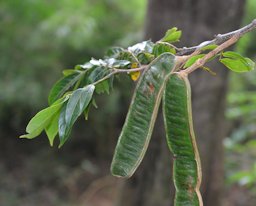 Fig. 17  |
Inga
densiflora Benth. Common names: Guatemala: guaba; Ecuador: guaba machetona, guava machete, wanya bene; Costa Rica: guaba salada; Colombia: navo 7 Synonyms: I. langlassei Pittier, I. monticola Pittier, I. heinei Harms, I. java Pittier, I. sordida Pittier, I. titiribiana Britton & Killip, I. montealegrei Standl., I. mollifoliola Pittier, Feuilleea densiflora (Benth.) Kuntze, I. microdonta Britton & Killip 7,10 Range: Pacific South America (including the high Andes), Amazonian South America, southern Central America (Costa Rica, Panama) 4
|
||||||||||||||||||||||||
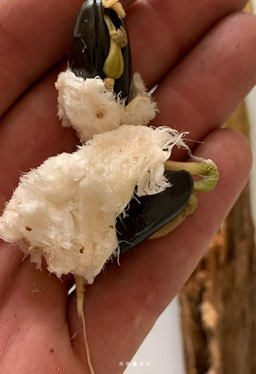 Fig. 21  |
Inga edulis Mart Ice Cream Bean, Inga edulis Page
|
||||||||||||||||||||||||
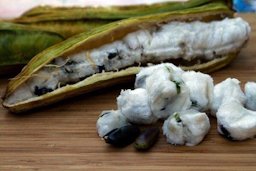 Fig. 23  |
Inga feuillei Common names: Quechua: pa'qay, paccai (Cuzco); Aymara: pa'qaya; Spanish: pacay, pacae, pacay de Perú, guama, guamo; English: ice-cream beans, food inga; French: pois sucre; Portuguese: ingá cipó, rabo de mico 11 Synonyms: I. cumingiana Benth., I. edulis sensu auct. (Misapplied), I.feuillei DC. (Spelling variant) 12 Range: Pacific South America (including the high Andes) 4 Further Reading Pacay, Inga feuillei Page |
||||||||||||||||||||||||
| Inga ilta
T.D. Penn. Common names: Ecuador: goto dan, guaba ilta, ilta 7 Range: Napo Province, Ecuador and Iquitos in Amazonian Peru, Amazon 4 The cultivated form of I. ilta, which is commonly found in gardens of the local Quichua people, has a very large legume containing up to 25 seeds, each surrounded by a copious pulp. The large size of the seeds (c. 4 x 2.5 cm) ensures that one legume provides a very large 'snack', more than enough for one person. The large edible embryos are cooked and eaten in soups. 4 Inga ilta is one of the fastest growing Amazonian Inga species yet encountered, exceeded only by the well known I. edulis. It is more profusely branched than I. edulis, and its leaflets are larger and much thicker. It therefore casts a deeper shade and the leaves, which take longer to break down, rapidly form a long-lasting and thick leaf litter. The ability of I. ilta to establish and flourish on poor acidic compacted soils has been shown. 4 |
|||||||||||||||||||||||||
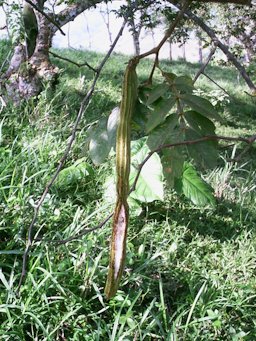 Fig. 24  |
Inga ingoides
(Rich.) Willd. Common names: Bolivia: pacae; Brazil: ingá, ingá cipo; Dominica: pois doux marron, pois du maron; Peru: coto chupa, guabilla, guavilla; Guyana: waikey, warakusa; French Guiana: pois sucré; St. Lucia: cacoli; St. Vincent: Spanish ash; Surinam: swietieboontje, warapotre; Trinidad: pois doux; Venezuela: guama, guama rabo de mono, guamo blanco 7 Synonyms: Feuilleea bahiensis (Benth.) Kuntze, F. ingoides (Rich.) Kuntze, F. sesuya Kuntze. Inga bahiensis Benth., I. galibica Duchass. & Walp., I. laxiflora Benth., I. merianae Splitg., Mimosa ingoides Rich. 7,10 Range: Amazonian South America 4 The fruits of Inga ingoides are similar to those of the widely cultivated Inga edulis except that they are a little shorther and more slender. Furthermore, the furrowed pods of I. ingoides are yellow green when ripe, as opposed to olive green in the case of I. edulis. 2
|
||||||||||||||||||||||||
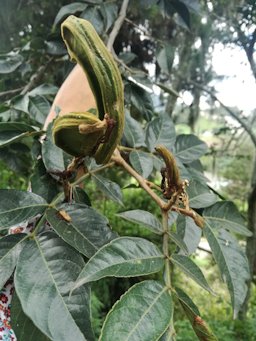 Fig. 30  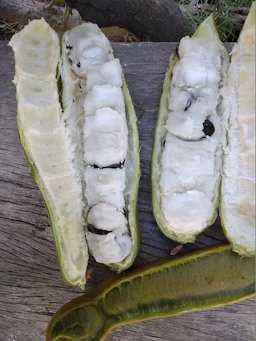 Fig. 31 |
Inga Insignis
Kunth Common name: Ecuador: guaba 7 Synonyms: Feuilleea insignis (Kunth) Kuntze, Inga ornifolia Kunth, I. pachycarpa Benth. 7,10 Range: Pacific South America (including high Andes) 4
|
||||||||||||||||||||||||
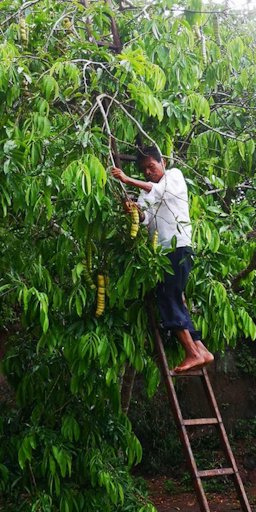 Fig. 39  |
Inga jinicuil Schltdl.
& Cham. ex G.Don 10 Inga jinicuil G. Don 7 Common names: Costa Rica: cuajinicuil, guabo caite; Mexico: chalahuite, cuil machetón, guajinicuil, jinicuil; Nicaragua: guava extranjeira; Guatemala, El Salvador, Honduras: paterno 7 Synonyms: Feuilleea inicuil (G.Don) Kuntze, Inga jinicuil Schltdl., I. paterno Harms, I. radians Pittier 4,10 Range: Mexico and northern Central America, southern Central America (Costa Rica, Panama) 4 In Guatemala, El Salvador and Costa Rica I. jinicuil (formerly regarded as distinct species I. paterno) is used to shade coffee and is also planted for its fruits. The fruit is among the best in the genus with thick, translucid and sweet pulp. 5
|
||||||||||||||||||||||||
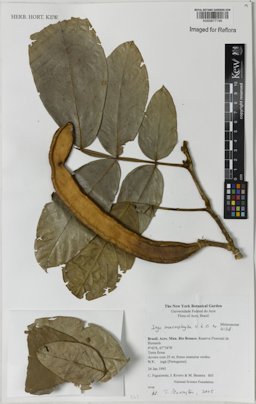 Fig. 42  |
Inga
macrophylla Humb. & Bonpl. ex Wild. Common names: ingapéua, ingá-peba, ingá, pacaí 5 Synonyms: I. alatocarpa T. S. Elias, I. brachyptera Benth., I. bracteosa Beth., I. calocephala Poepp., Mimosa macrophylla (Humb. & Bonpl. ex Wild.) Poir 5 Range: Central and Western Amazon, in forests and second growth on upland sites, but in fertile humid soils 5 The plant's voluminous fruit with a large proportion of edible pulp rivals that of the other two species, I. edulis and I. cinnamomea 8 A mature tree produces 100 to 150 fruits a year, one of the reasons the tree is so popular with river dwellers. The trunk often resemble modern art because the light gray bark is splotched with patches of colorful lichen. 3 Further Reading Inga macrophylla Page |
||||||||||||||||||||||||
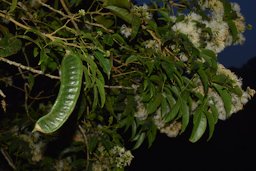 Fig. 43  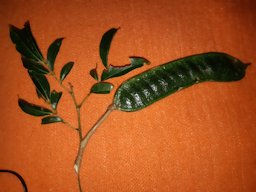 Fig. 44  |
Inga
mortoniana J.León Range: Central America to Colombia 10 Further Reading Ice cream bean, Inga mortoniana Page
|
||||||||||||||||||||||||
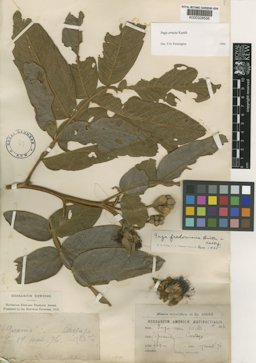 Fig. 48  |
Inga ornata
Kunth Common names: Columbia: guaba, guabo de osa, guama bejuco, guamo 7 Synonyms: Inga holtonii Pittier, I. codonantha Pittier, I. dolichantha L., I. eglandulosa T.S., I. fredoniana Britton & Killip, I. vallensis T.S. 7,10 Range: Pacific South America (including high Andes) 4 |
||||||||||||||||||||||||
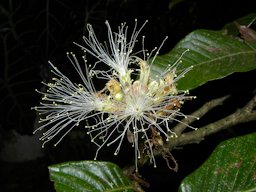 Fig. 49  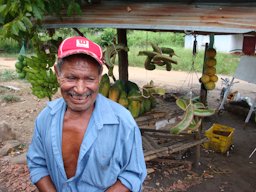 Fig. 50  Farmer from Yaracuy selling fruits and vegetables in the road, in the state of Yaracuy, Venezuela. It is very common to see people selling agricultural products in these rural areas as their only means of support. |
Inga
spectabilis (Vahl) Willd. Common names: English: silky inga; Spanish: guaba de machete, guava de machete, guava machete, guavo machete 6 Synonyms: Feuilleea spectabilis (Vahl) Kuntze, F. heteroptera (Benth.) Kuntze, I. schimpfii Harms; I. spectabilis var. schimpfii (Harms) Little, I. heteroptera Benth., I. lucida H.B.K., I. fulgens Kunth, I. smithii Britton, Mimosa spectabilis Vahl 6,7 Range: Pacific South America (including the high Andes), southern Central America (Costa Rica, Panama) 4
|
||||||||||||||||||||||||
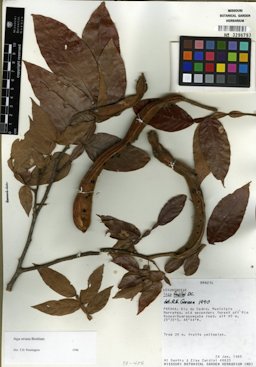 Fig. 59  |
Inga striata
Benth. Common names: Brazil: ingá, ingá banana, ingá branco, ingá de cuatro quina, ingá sabar, ingazeiro; Bolivia, Peru: pacae 7 Synonyms: Feuilleea catharinae (Benth.) Kuntze, F. nuda (Salzm. ex Benth.) Kuntze, F. salzmanniana (Benth.) Kuntze, I. canaminensis Rusby, Inga catharinae Benth., I. nuda Salzm. ex Benth., I. dulcis (Vell.) Mart., I. salzmanniana Benth. 7 Range: South east Brazil 4 |
||||||||||||||||||||||||
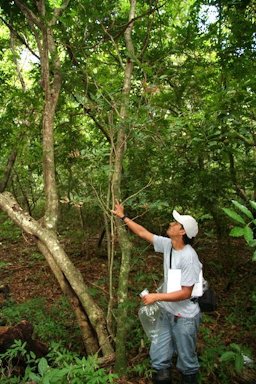 Fig. 60  Area de Conservacion Guanacaste, Costa Rica Back to Ice Cream Bean Page |
Inga
vera Willd. Common names: ingá-do-brejo, ingá-de-quatro-quinas, ingazeiro, ingá-banana, ingá, angá 9 Synomys: Feuilleea inga (L.) Kuntze, Mimosa inga L., I. vera subsp. affinis, I. vera subsp. eriocarpa, I. vera subsp. vera 7 Range: Dominican Republic, Haiti, Jamaica, Puerto Rico 14 I. vera is suitable to the climate of the humid tropics with a high rainfall. 14 The name ‘inga’ is derived from its name with the Tupi Indians of South America. The specific Latin name, ‘vera’, means ‘true’ or ‘genuine’. Based on material collected in Jamaica, this species was the first to be named and the one upon which the classification of the rest of this large genus was based. 14 Pioneer plant adapted to humid soils, suitable for heterogeneous reforestation in reclaimed and protected areas. 9 Further Reading Inga vera Page
|
||||||||||||||||||||||||
| Bibliography 1 Lorenzi, Harri, et al. Brazillian Fruits & Cultivated Exotics (for consuming in natura). Nova Odessa, Instituto Plantarum de Estudos da Flora, 2006. 2 Smith, Nigel, et al. Amazon River Fruits, Flavors for Conservation. Lima, Peru, Missouri Botanical Garden Press, 2007. 3 "Inga cinnamomea Spruce ex Benth." Plants For A Future, pfaf.org/user/Plant.aspx?LatinName=Inga+cinnamomea. Accessed 17 May2020. 4 The Genus Inga Utilization. Edited by T. D. Pennington, and E. C. F. Fernandes, Belgium, Continental Printing, 1998. 5 Lorenzi, Harri. Brazilian Trees, A Guide to the Identification and Cultivation of Brazilian Native Trees. Vol. 3. Nova Odessa, Instituto Plantarum de Estudos da Flora, 2009. 6 "Inga spectabilis (Vahl) Willdenow, Fabaceae." Pacific Island Ecosystems at Risk, PIER, hear.its.hawaii.edu/pier/species/inga_spectabilis.htm. Accessed 6 Oct. 2020. 7 "Inga spp." Mansfeld's Database of Agricultural and Horticultural Plants, mansfeld.ipk-gatersleben.de/apex/f?p=185:3. Accessed 6 Oct. 2020. 8 "Food and fruit-bearing forest species 3: Examples from Latin America." FAO Forestry Paper 44/3, FAO Forestry Department, Food and Agriculture of the united Nations, Rome, 1986, FAO, www.fao.org/3/ap368e/ap368e00.pdf. Accessed 11 Oct. 2020. 9 Lorenzi, Harri. Brazilian Trees, A Guide to the Identification and Cultivation of Brazilian Native Trees. Vol. 1. 4th ed., Nova Odessa, Instituto Plantarum de Estudos da Flora, 2002. 10 "Inga spp." Plants of the World Online Portal, Facilitated by the Royal Botanic Gardens, Kew, POWO, (CC BY 3.0), www.plantsoftheworldonline.org. Accessed 11 Oct. 2020. 11 "Lost Crops of the Incas: Little-Known Plants of the Andes with Promise for Worldwide Cultivation." National Research Council (U.S.), Advisory Committee on Technology Innovation, 1989, ETDF, epdf.pub/lost-crops-of-the-incas-little-known-plants-of-the-andes-with-promise-for-worldw.html. Accessed 28 May 2020. 12 "Synonyms for Inga feuillei DC." The Plant List (2013), Version 1.1, www.theplantlist.org. Accessed 28 May 2020. 13 Recher, Paul. "Ice cream bean, Inga mortoniana." Fruit Spirit Botanical Garden, Dorroughby, NSW, Quandong vol. 19, no.4, Fourth quarter 1993, Archives of the Rare Fruit Council of Australia, Jan. 1995, rfcarchives.org.au/Next/Fruits/Inga/IngaMortoniana1-95.htm. Accessed 17 May 2020. 14 Orwa, C., et al. "Inga vera." Agroforestree Database: a tree reference and selection guide, version 4.0, 2009, Agroforestry, apps.worldagroforestry.org/treedb2/speciesprofile.php?Spid=1000. Accessed 21 Oct. 2020. 15 Cavalcante, Paulo B. "The Ingas of the Brazilian Amazon." Archives of the Rare Fruit Council of Australia, Tropical Fruit News, Nov. and Dec. 1990, Mar. 1994, rfcarchives.org.au/Next/Fruits/Inga/Inga3-94.htm. Accessed 5 Apr. 2020. Photographs Fig. 1 Pérez, R. "Inga bella M. Sousa, Fabaceae." STRI Observations, Panama, Colon, Fort Sherman Canopy Crane, Neotropical Flora, (CC BY-NC 3.0), serv.biokic.asu.edu/neotrop/plantae/taxa/index.php?taxon=42917. Accessed 17 May 2020. Fig. 2,3,4,5,6,7,8,9,10,11,12,13,14 Aguilar, Reinaldo. "Inga bella M. Sousa." Vascular Plants of the Osa Peninsula, Costa Rica, 2 Apr. 2014, (CC BY-NC-SA 2.0), Flickr, www.flickr.com/search/?user_id=56339362%40N03&view_all=1&text=inga bella. Accessed 17 May 2020. Fig. 15 "Inga spectabilis (Vahl) Willd." Annals of the Missouri Botanical Garden (1914-2013), vol. 37, t. 76, p. 200, 1950, Missouri Botanical Garden, St. Louis, U.S.A., Plant Illustrations, www.plantillustrations.org/illustration.php?id_illustration=116718. Accessed 16 Oct. 2020. Fig. 16 Mgb. "Inga cinnamomea Spruce ex Benth." Herbarium Specimen, Missouri Botanical Garden, 7463, Tropicos®, (CC BY-NC 4.0), www.tropicos.org/Image/100497312. Accessed 20 Oct. 2020. Fig. 17,18 Villalobos, Nelson Zamora. "Inga densiflora Benth." Pl@ntNet observations, 17 Apr. 2019, GBIF, (CC BY-NC-SA), www.gbif.org/occurrence/2643580585. Accessed 11 Oct. 2020. Fig. 19 Lewis, G. P. "Inga densiflora Benth." Plants of the World Online, Facilitated by the Royal Botanic Gardens, Kew, POWO, (CC BY 3.0), www.plantsoftheworldonline.org/taxon/urn:lsid:ipni.org:names:128466-2. Accessed 11 Oct. 2020. Fig. 20 Aguilar, Reinaldo. "Inga densiflora Benth." Vascular Plants of the Osa Peninsula, Costa Rica, 2 Apr. 2014, (CC BY-NC-SA 2.0), Flickr, www.flickr.com/search/?user_id=56339362%40N03&view_all=1&text=Inga densiflora. Accessed 17 May 2020. Fig. 21,22 Starry, Joshua. "Inga edulis." Vermented, www.instagram.com/p/CCG-uCKjL1M/?igshid=hxappqm2k9zv. Accessed 24 Oct. 2020. Fig. 23 Ivan. "Ever take an ice cream bean for dessert?" Random Times, Public Domain, random-times.com/2018/07/18/ever-take-an-ice-cream-bean-for-dessert/. Accessed 7 Apr. 2020. Fig. 24,27 Marín, Oscar H. "Inga ingoides, Córdoba, Quindío, Colombia." iNaturalist Research Grade Observations, 2 Jan. 2019, (CC BY-NC 4.0), www.inaturalist.org/observations/19380766. Accessed 12 Oct. 2020. Fig. 25,26,29 Marín, Oscar H. "Inga ingoides, Quimbaya, Quindío, Colombia." iNaturalist Research Grade Observations, 10 Dec. 2018, (CC BY-NC 4.0), www.inaturalist.org/observations/18949464. Accessed 12 Oct. 2020. Fig. 28 Vásquez, Rodolfo. "Inga ingoides (Rich.) Willd. Peru." Herbarium Specimen, Missouri Botanical Garden, 34990, Tropicos®, (CC BY-NC 4.0), www.tropicos.org/Image/100390236. Accessed 20 Oct. 2020. Fig. 30 natusix. "Inga insignis, Parroquia El Sagrario, Ibarra, Ecuador." iNaturalist Research Grade Observations, 28 Jan. 2020, (CC BY-NC 4.0), www.inaturalist.org/observations/38063906. Accessed 20 Oct. 2020. Fig. 31,34 "Inga insignis, Guaba." Repositorio Digital: Flora de la Mitad del Mundo, 2 Feb. 2019, (CC BY-NC-SA 2.0), Flickr, www.flickr.com/photos/154043720@N05/47108806252. Accessed 20 Oct. 2020. Fig. 32 Carrera, Michelle. "Inga insignis Kunth, Cd Bicentenario, Quito, Ecuador." iNaturalist Research Grade Observations, 4 Sept. 2020, (CC BY-NC 4.0), www.inaturalist.org/observations/58540849. Accessed 16 Oct. 2020. Fig. 33,35 paola_buitron. "Inga insignis, Quito, Ecuador." iNaturalist Research Grade Observations, 1 Sept. 2020, (CC BY-NC 4.0), www.inaturalist.org/observations/58288309. Accessed 20 Oct. 2020. Fig. 36 jsci2712. "Inga insignis Kunth, Valle de Quito, Andean Ecuador." iNaturalist Research Grade Observations, 22 Sept. 2020, (CC BY-NC 4.0), www.inaturalist.org/observations/60431438. Accessed 16 Oct. 2020. Fig. 37 Martius, C. F. P. von, et al. "Inga cinnamomea Benth." Flora Brasiliensis, vol. 15(2), Missouri Botanical Garden, St. Louis, U.S.A. 1870-1876, Plant Illustrations, www.plantillustrations.org/illustration.php?id_illustration=14320. Accessed 16 Oct. 2020. Fig. 38 "Inga insignis Kunth." Plants of the World Online, Facilitated by the Royal Botanic Gardens, Kew, Herbarium, RBG Kew, K0003288575, POWO, (CC BY 3.0), www.plantsoftheworldonline.org/taxon/urn:lsid:ipni.org:names:128550-2. Accessed 16 Oct. 2020. Fig. 39 Caballero, Miguel A. Chavez. "Inga jinicuil, Ixhuacán de los Reyes, Ver., México." iNaturalist Research Grade Observation, 11 Aug. 2019, (CC BY-NC 4.0), www.inaturalist.org/observations/30594059. Accessed 12 Oct. 2020. Fig. 40 Pedro. "Inga jinicuil, Los Sauces, Xalapa, Veracruz." iNaturalist Research Grade Observation, 7 July 2015, (CC BY-NC 4.0), www.inaturalist.org/observations/1732664. Accessed 12 Oct. 2020. Fig. 41 Aguilar, Reinaldo. "Inga jinicuil Schltdl. Inflorescencia en capítulo mostrando el proceso de maduración de las flores de la base hacia el ápice." Instituto National de Biodiversidad, via Encyclopedia of Life, Costa Rico, 13110849, EOL, (CC-BY-NC-SA-3.0), eol.org/pages/416740/media. Accessed 12 Oct. 2020. Fig. 42 "Inga macrophylla Humb. & Bonpl. ex Willd." Plants of the World Online, Facilitated by the Royal Botanic Gardens, Kew, Herbarium, RBG Kew, K000877198, POWO, (CC BY 3.0), www.plantsoftheworldonline.org/taxon/urn:lsid:ipni.org:names:128596-2. Accessed 16 Oct. 2020. Fig. 43,44 Rojas, Emmanuel Rodríguez."Inga mortoniana J. León, Costa rica." iNaturalist Reseach Grade Observations, 7 Oct. 2019, (CC BY-NC 4.0), www.inaturalist.org/photos/53498738 Fig. 45,46,47 Villalobos, Nelson Zamora. "Inga mortoniana J. León." Pl@ntNet observations, Occurrence dataset doi.org/10.15468/gtebaa, via GBIF, 17 Apr. 2019, (CC-BY-NC-SA), www.gbif.org/occurrence/2645045526. Accessed 21 Oct. 2020. Fig. 48 "Inga ornata Kunth." Plants of the World Online, Facilitated by the Royal Botanic Gardens, Kew, Herbarium, RBG Kew, K000877198, POWO, (CC BY 3.0), www.plantsoftheworldonline.org/taxon/urn:lsid:ipni.org:names:500662-1. Accessed 16 Oct. 2020. Fig. 49,51,52,53,54 Aguilar, Reinaldo. "Inga spectabilis (Vahl) Willd." Vascular Plants of the Osa Peninsula, Costa Rica, 1 July2012, (CC BY-NC-SA 2.0), Flickr, www.flickr.com/search/?text=inga spectabilis. Accessed 11 Oct. 2020. Fig. 55,56 Paton, Steve. "Inga spectabilis Willd." Plant Field Observations, Smithsonian Tropical Research Institute, Panama, Barro Colorado Island, 5 July 2005, STRI, (CC0 1.0), stricollections.org/portal/collections/individual/index.php?occid=907431. Accessed 24 Oct. 2020. Fig. 50,57 Wilfredor. "Farmer from Yaracuy selling fruits and vegetables in the road, in the state of Yaracuy, Venezuela. It is very common to see people selling agricultural products in these rural areas as their only means of support." Wikimedia Commons, 29 June 2009, (CC BY-SA 3.0), GFDL, Image cropped, commons.wikimedia.org/wiki/File:Campesino_Venezolano,_Edo._Yaracuy.jpg. Accessed 11 Oct. 2020. Fig. 58 "Inga spectabilis (Vahl) Willd." Annals of the Missouri Botanical Garden, vol. 37, Missouri Botanical Garden, St. Louis, U.S.A. 1950, Plant Illustrations, www.plantillustrations.org/illustration.php?id_illustration=116718. Accessed 16 Oct. 2020. Fig. 59 Mgb. "Inga striata Benth., Brazil." Herbarium Specimen, Missouri Botanical Garden, 49823, Tropicos®, (CC BY-NC 4.0), www.tropicos.org/Image/100328824. Accessed 20 Oct. 2020. Fig. 61,62 Janzen, Daniel H. "Inga vera Willd." The International Barcode of Life Consortium, Area de Conservacion Guanacaste, Costa Rica, 24 July 2008, GBIF, (CC BY-NC-SA 4.0), www.gbif.org/occurrence/2250942183. Accessed 11 Oct. 2020. Fig. 63 Orozco, Adrianh Martínez. "Inga vera Willd." iNaturalist Research Grade Observation, Xalapa-Enríquez, Ver., México, 3612491026, 27 Apr. 2019, (CC BY 4.0), www.inaturalist.org/photos/36124910. Accessed 11 Oct. 2020. Fig. 64 Villalobos, Nelson Zamora. "Inga vera Willd." Pl@ntNet observations, Costa Rica, 17 Apr. 2019, GIBF, (CC BY 4.0), www.gbif.org/occurrence/2644931394. Accessed 11 Oct. 2020. Fig. 65 Dácio Dácio. "Inga vera Willd." Pl@ntNet observations, Brazil, 24 Feb. 2020, GBIF, (CC BY 4.0), www.gbif.org/occurrence/2645907817. Accessed 11 Oct. 2020. Fig. 66 Ruiz, H., and J. Pavón. "Inga vera Willd." Drawings of the Royal Botanical Expedition to the Viceroyalty of Peru, Real Jardín Botánico, Madrid, Spain, 1777, Plant Illustrations, www.plantillustrations.org/illustration.php?id_illustration=282126. Accessed 16 Oct. 2020. Published 12 Nov. 2020 LR |
|||||||||||||||||||||||||
